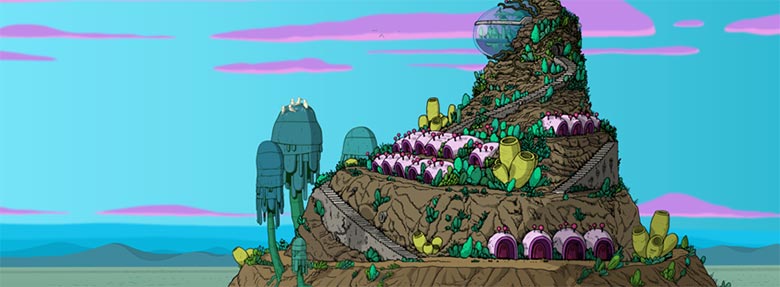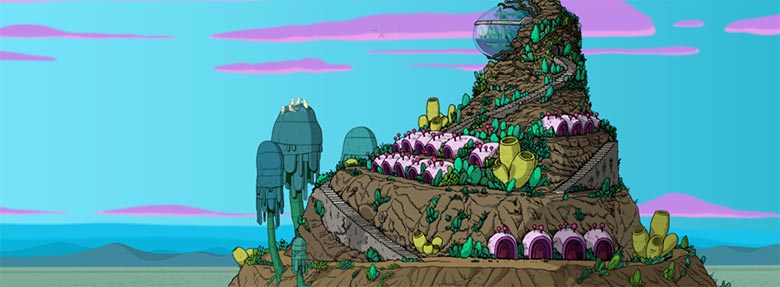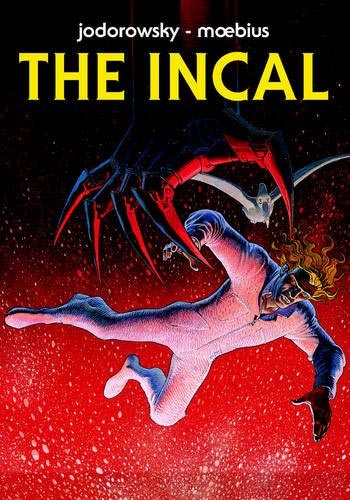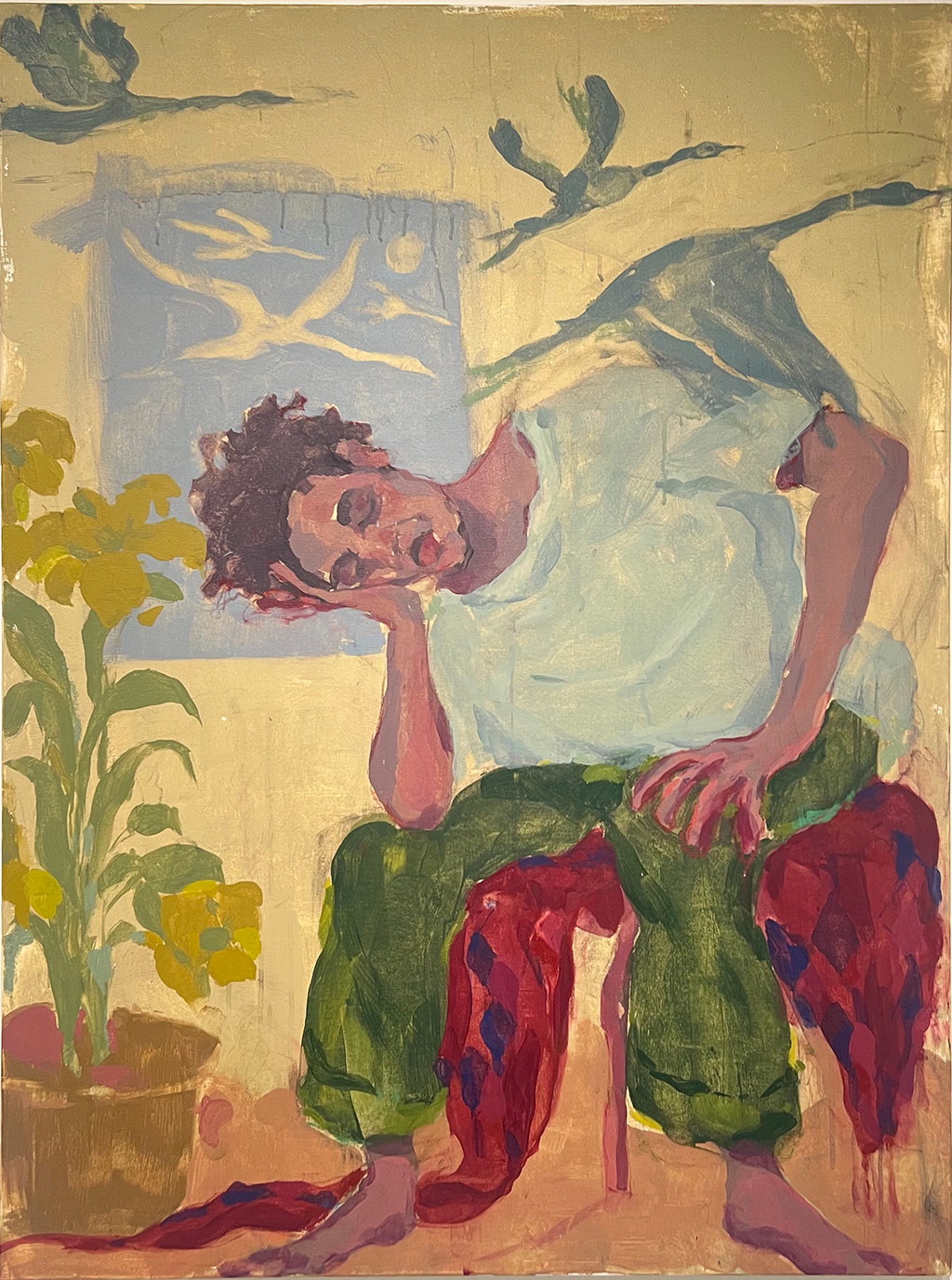
“Intergalactic slavery going on within this closed system,” says Chad VanGaalen, describing a fictional world of his creation. “I basically started making the planet… Then I was like, ‘Oh, it’s going to be this mining community.” Surprise, surprise, like that’s never been used before…”
And that right there is about as close to “conventional” as Chad VanGaalen comes.
2014’s Shrink Dust is VanGaalen’s first album in almost exactly three years. Described by its creator as a “sci-fi folk record”, it takes the sound of its predecessor from 2011, Diaper Island, and, through the introduction of a pedal steel guitar, amplifies a certain country element that’s been rumbling around in the background for a while. That influence appears as early as the first track, “Cut Off My Hands”, which drifts in on a sweet calm that’s reminiscent of the quieter moments of, say, Joel R.L. Phelps and the Downer Trio. VanGaalen album-openers can be deceptively mellow, though, and “Cut Off My Hands” is chased by the propulsive, television snow Madchester-ness of “Where Are You”. Spiraling through it all are his trademark traits and nuances: the spectral vocal quiver, melodic pivots and bursts, the stretching of a single word like “evil” to the length of a sentence…
A LONG TIME AGO, IN A GALAXY FAR, FAR AWAY…
Almost from the time that Diaper Island was in the can, VanGaalen began creating his first full-length animated feature, a science fiction film that eventually took on the name, Translated Log of Inhabitants. Conceived, illustrated, and narrated entirely by him, the film’s release is expected to happen sometime this year. Shrink Dust wasn’t intended to be simply the soundtrack to the film, though the album and the film are thematically linked. Dissecting all the songs won’t exactly reveal the plot, but the two projects were definitely informing each other — “coming from the same sort zone in my mind,” as VanGaalen puts it. “People keep on saying that it is the score to the film, which it’s really not,” he clarifies. “It’s more of a companion to it or something.”
Before Translated Log, VanGaalen had never written a script before. When he began work on the film, he assembled pieces he was generating in a non-linear fashion, which is typical for his workflow. Soon, though, he ran into difficulty trying to integrate the different scenes into a cohesive narrative. Much of the work on the film and the record happened concurrently, and the progress he was making on the film informed the themes of what ended up on Shrink Dust, as a result of his trying to keep his “head in the zone”. So, for instance, while some songs are more self-contained, tracks like “Cosmic Destroyer” are directly related to the development of one of the characters in the story.
It’s not always easy to tell which elements of Shrink Dust directly correspond to Translated Log. The title of the record seems at first like it must have stemmed from the film, but it actually came from fellow Calgary musician, Matt Flegel — the former bass player for Women, who now plays with Viet Cong — when they were “thinking up stupid band names.” It quickly occurred to VanGaalen that it would be an appropriate name for the record. Title in hand, he then came up with the cover drawing — a sort of living, light-hearted monster Matryoshka doll.
Naturally, Shrink Dust and Translated Log of Inhabitants share the same influences — one of the most prevalent being VanGaalen’s favorite graphic novel of all time, The Incal by Alejandro Jodorowsky and illustrator Jean Giraud, aka Moebius. He was reading that book’s sequel during the creative process, and, in general, was trying to absorb as much sci-fi as he could. Subsequently, the song “Frozen Paradise” was inspired by The Incal 2, and others like “All Will Combine” and “Cut Off My Hair” are loosely, if not entirely, drawn from those wells.
Considering Jodorowsky and Moebius’ combined influence on his own, multi-disciplinary, work, VanGaalen admits that he finds Jodorowsky’s non-linear approach to storytelling particularly intriguing.
“You’re left at the end of [his stories] really not even knowing what necessarily the point was. Or, especially with The Incal, it starts where it ends, so you’re really like, ‘Wow, that’s an amazing feat in itself,'” VanGaalen explains, “because… it’s like cyclical motion going on inside of the storytelling, and, yeah, it’s more than a feeling.”
He goes on to also praise Moebius, who VanGaalen describes as his “favorite illustrator of all time”. A founding member of the art group Les Humanoides Associes, Moebius and co. were responsible for creating Heavy Metal magazine (Métal Hurlant), a French comics anthology of science fiction and horror comics stories, in December 1974.
“[Moebius] definitely set the bar and made everybody look like a pile of shit in that magazine,” recalls VanGaalen. “I remember picking up Heavy Metal magazine a few times and saying, ‘Yeah, yeah, that’s pretty cool, it’s like kitties and monsters and stuff,’ and then you hit the Moebius [section], and you’re like, ‘What the fuck?’ It’s so perfect, especially his cityscapes and his imagination of this… techno future. It’s stood the test of time so well. Seriously, I still look at it. ‘The Airtight Garage’ is one of my favorite Moebius stories.”
As early as the age of twelve, VanGaalen was absorbing Moebius’ techniques into his own illustrations — be it through the perspective and background, the use of certain colors and hatching, or in making his aliens fatter and giving them more arms. Moebius’ combination of looseness and detail, what his characters wore, the composition of each frame: all had an effect on how VanGaalen came to approach his own illustrations.
“It’s like European comics at that time just had something that American comics didn’t,” says VanGaalen. “And I think it was… that imagination… they were blending a lot more elements into it than just this pulp stupidity, which is where American comics were at, at the time.”
Sometime over the summer of 2013, word began to circulate that Nicolas Winding Refn, the director of Drive, was working on a film adaptation of The Incal. Considering whether it would translate well into film, VanGaalen ultimately feels that an animation would be the best representation of the book, but is excited about the prospect nonetheless.
“It’s always a touchy subject when one classic gets translated into a movie. I think Blade Runner might be the one movie that somebody didn’t manage to fuck up completely, as far as translating that story. And, I mean, he did fuck it up in a way,” VanGaalen says. “How are you going to tell that story in an hour-and-a-half really?”
In The Beginning, Chad Created The Heavens And The Earth
 When VanGaalen started constructing the planet for Translated Log of Inhabitants, he thought about it firstly in physical terms — what would be there, and what would be happening. He also wanted the story to apply somewhat to himself, so the first character that appears is, as he tells it, kind of him in a way. Except that his animated alien counterpart sorts through space junk and debris all day long. Space junk that may or may not be used to make some kind of a space weapon. Or not; VanGaalen doesn’t want to give too much of the story away at this point.
When VanGaalen started constructing the planet for Translated Log of Inhabitants, he thought about it firstly in physical terms — what would be there, and what would be happening. He also wanted the story to apply somewhat to himself, so the first character that appears is, as he tells it, kind of him in a way. Except that his animated alien counterpart sorts through space junk and debris all day long. Space junk that may or may not be used to make some kind of a space weapon. Or not; VanGaalen doesn’t want to give too much of the story away at this point.
When it comes down to it, he says, the film is like a “space comedy”, somewhere in the tradition of movies like Muppets in Space, or that eternal Saturday afternoon network staple, Spaceballs. With humor and the human element missing from so much modern sci-fi, VanGaalen is looking to create something that’s easier to latch onto.
“I definitely want it to be funny as hell. That’s the other thing with The Incal. They really knew how to inject that stuff with humor,” he says. “I feel like maybe that’s what American comics were lacking as well. There was a real human element to the sci-fi that was coming out at that time. Everybody wasn’t ripped and people were still wearing fucking sombreros, you know what I mean?”
Another part of bringing the world of Translated Log of Inhabitants to fruition was in creating the said log itself; an illustrated compendium of up to 150 characters done in the style of similar Dungeons & Dragons guides. Still in development, the compendium first occurred to VanGaalen when he was on tour and coming up with character ideas. He would start by drawing one, and would then come up with a photo bio on the bottom. He quickly realized what it was starting to resemble.
“…I was like, ‘Oh, this is actually D&D. I’ve actually regressed into my 14-year-old self and I’m fully making a D&D book right now,'” he laughs. “Then once I came to terms with that, I was like, ‘Fuck yeah, I’m making a D&D book. This is rad.'”
VanGaalen finds it hard to understand why anyone would want to pick up a physical, illustrated manual that might actually weigh something, given how predisposed people have become to consuming things digitally. Yet he continued to pursue the compendium for the sheer fun of it, fueled by the basic idea that it would be a nice thing to get the real “translated log”, and have it as a three dimensional book — though with something like a download code on the back for the movie, of course.
“I really wanted it to be a real thorough investigation… of this world that I’m making,” VanGaalen muses. “It forced me to really think about [things] like, ‘What plants are growing there? Do they have a problem with those plants? Are they trying to eradicate certain plants? Do they eat the plants? What the plants eat?’ As you start writing about those things in detail, or imagining how they would work in an environment, or even in an ecosystem, then those things really start to develop, and relationships to those things start to develop as well. It’s more or less… a tool to get me into it a little bit deeper.”
The natural suspicion here would be that VanGaalen was a big fan of Dungeons & Dragons growing up, but that was not the case at all. In fact, he confesses to having hated D&D, finding it all very underwhelming as an adolescent. “I remember kids inviting me over to draw… like, ‘Let’s draw the sickest fucking battle elf,'” he recalls. “Then I’d go over and I’d draw the character, and then I’d feel like, ‘Seriously?'”
Rolling the twenty-sided die in a basement may not have captured his imagination, but he has since come to understand D&D‘s appeal and that it can be an awesome thing in its own right. “I’m not getting down on D&D, but when I was a kid I just wanted a skateboard,” he says, reflecting on how inspired he was by skateboard art. ‘If I can draw as good as any of the Santa Cruz graphics’… it was just all about skeletons on boards, man, it was so awesome.”
Along similar lines, VanGaalen was also very much into Marvel Universe and DC Who’s Who. Comics like Origins of Spiderman showed all of the hero’s gear and how things came about, as well as presented stories that he became very involved with; he read his original issues over and over again until they were in tatters. More than any narrative, even, he was drawn to sections that pertained to elements such as what vehicles were used — details that many would consider the more superfluous elements.
Press photo by Marc Rimmer
Chad VanGaalen – “Where Are You?” Music Video
New Toys & Space Cowboys

RELATED ARTICLE
Chad VanGaalen Interview (2011): Animated Video Retrospective
Intriguing details have stood out in VanGaalen’s songwriting as far back as his 2003 debut, Infiniheart. One of the pleasures in picking up a new album of his is in the anticipation of both knowing and not knowing what to expect. That spontaneity was perhaps most strongly present on Soft Airplane (2008); the record spun on a dime from “Bare Feet on Wet Griptape”, which beat the New Pornographers at their own game, to “Phantom Anthills”, with its squishy rhythms. Comparatively, Shrink Dust is subtle in its contrasts, but that new pedal steel guitar is impossible to miss.
For a long time, the prohibitive cost and size of a pedal steel guitar kept VanGaalen from getting one. Once he finally did, though, he started to incorporate it into every song he could. Anyone who has even tried to play a pedal steel will attest that it is a complicated instrument, and with so many other things occupying his time, it took VanGaalen a while to feel proficient enough to put the instrument on record. Considering that it took him two months to even get it properly in tune, he admits that he may never have the time to become a pedal steel virtuoso, but he’s come to love how open-ended the instrument is.
“It’s really great for improvised music, because there’s so much range… you can morph anywhere; there’s no beginning and no end to a note,” says VanGaalen, almost recalling what he loves most about Jodorowsky’s The Incal. “I really love it for improvised stuff and sound effects.”
As one might suspect, VanGaalen was going through “a real country phase” around the time of making Shrink Dust. After finally getting the pedal steel tuned into playable shape, it was added to the songs as they came out. The introduction of the new instrument didn’t so much alter his process as much as it complimented a mode of songwriting that he was already delving in to.
“There were a few ones that I had redone [for Shrink Dust]. ‘Weighed Sin’ had come out a couple of years ago on a German release, and I was never really happy with it,” explains VanGaalen. “It was really, really fast, and I wanted it to be a slower country song, so I rerecorded it and put pedal steel on that and then… I started putting it on all of the slower country songs… it fits on really well. You don’t necessarily notice it, but it definitely adds a mellow vibe to everything.”
Touring the US through May and June, VanGaalen will be joined by opener Brian Webb, formerly of the Constantines. Webb will be bringing his pedal steel guitar to play along with him, but for now, it doesn’t look like the two will be collaborating on stage to bring those softer passages of Shrink Dust to life. The set VanGaalen has in mind leans toward the “louder, rocky sound” of songs like “Where Are You” and “Frozen Paradise.” Even from a merely logistical standpoint, bringing along the unwieldy pedal steel guitar seemed troublesome.
“It is a major element on the record, but to bring [it] along for like two songs when nobody can really play it and nobody really wants to play it, I’m like, ‘No, whatever,'” says VanGaalen. “We’ll just sing those lines or something like that…. I like it when a band plays the song like it is on the record, but at the same time, sometimes I don’t.”
Shrink Dust‘s dual influences of science fiction and country music might seem inherently disparate, but no such notion ever occurred to VanGaalen. The results came out of his tried-and-true process of making “piles of songs” and then seeing what works best before trimming the fat and sequencing it all at the end. The only thing he specifically had in mind was that he wanted another record like Diaper Island, with its noisier garage rock sound. Similarities in acoustics are audible –at least somewhat related to the fact that VanGaalen records everything in his home studio, Yoko Eno — but Shrink Dust certainly has its own distinct personality. The final tracklist is what remains of an editorial collision between clusters of similar songs: beat-driven looping numbers like “Where Are You”, a collection of country songs, and so on.
Those songs that didn’t make the cut should eventually become available online via Flemish Eye, the Calgary-based record label that releases the work of VanGaalen — and that of a number of other fine bands, like WOMEN. There were no less than two B-sides records that followed Diaper Island, and he believes that there will be two or three more full of Shrink Dust-period songs that will surface.
“I think there are ten records up on the site right now that you can pick from that are more or less B-side stuff. There’s also a bunch of Black Mold stuff, which is just more sort of ambient. It goes anywhere from sheer noise to drumming, to beats or other stuff, too. Which is good, because I feel like I never had an outlet for that in the past,” explains VanGaalen.
With half of the money from sales of all of this bonus material going to charity, completionists can feel especially good about gathering up every last song.
“It’s awesome, because people get a shitload of bonus material, and they feel good about it,” VanGaalen says.” We’re going to do something [charitable] with the parks around here, like in the Rockies, something that’s more local to town because… it’s weird to not know where things go.”
If not the parks, he concludes, then perhaps to local schools. It is a generous way to bring out a generous amount of music, befitting the abundant spirit of VanGaalen’s cross-platform art.
Ω










[…] attention to detail to a bigger audience, and he has been hard at work on an animated feature, Translated Log of the Inhabitants, for a couple years now. Though, as he tells us here, the animators responsible for Adult Swim may […]
[…] http://www.redefinemag.com/2014/chad-vangaalen-artist-interview-sci-fi-visions-sight-sound/ […]